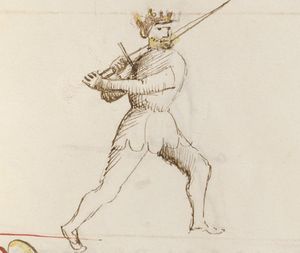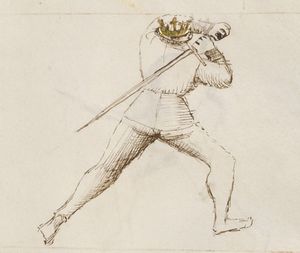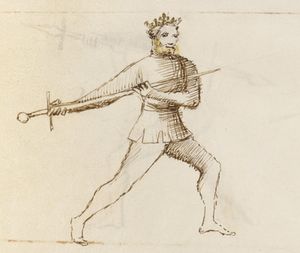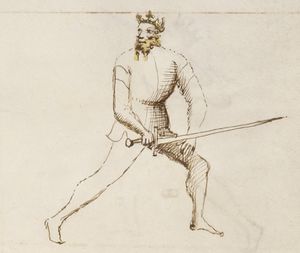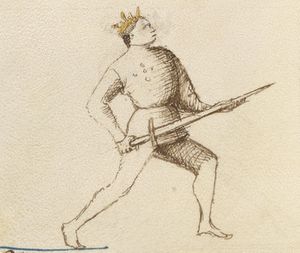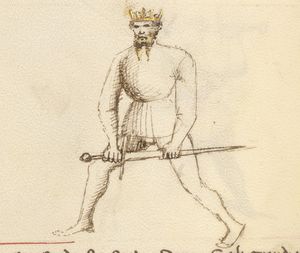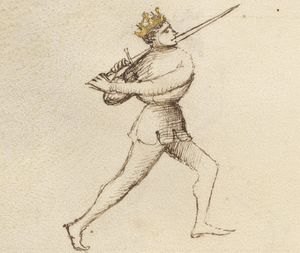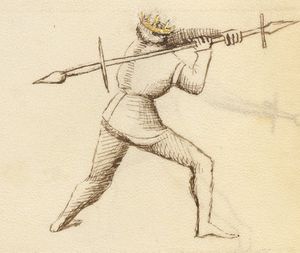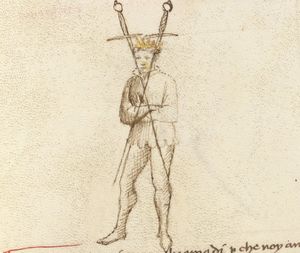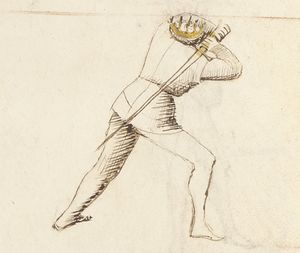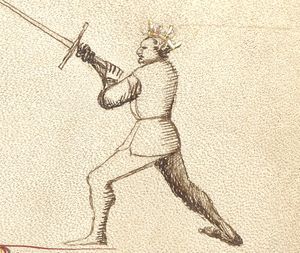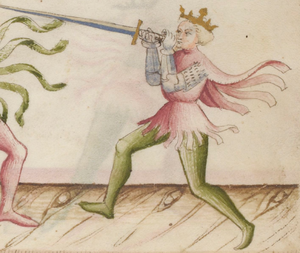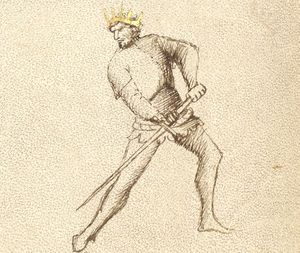|
|
You are not currently logged in. Are you accessing the unsecure (http) portal? Click here to switch to the secure portal. |
Fiore de'i Liberi/Sword in Two Hands
Images |
Images |
PD |
Morgan Transcription [edit] |
Getty Transcription [edit] |
|||
|---|---|---|---|---|---|---|---|
[1] Six Masters we are, and we dispute one to another We are two guards, one is made like the other, and one is the countrary to the other. And any other guard in the art is similar to the other, and is its contrary, except the guards which stay in point/thrust, which are Posta Lunga [Long Position] and Breve [Short Position] and Meza Porta di Ferro [Half Iron Door], because point by point the longer one offends before. And what the one can do, the other can. And each guard can do Volta Stabile [Stable Turn] and Meza Volta [Half Turn]. Volta Stabile [Stable Turn] is when standing still, you can fight in front and behind on one side. Meza Volta [Half Turn] is when one makes a pass forwards or backwards, so that he can fight on the other side in front and behind. Tutta Volta [Full Turn] is when one goes turning about one foot with the other foot; the one stands firm and the other circles. And because of that, I say the sword has three movements, which are Volta Stabile, Mezza Volta and Tutta Volta. And these guards are called, the one and the other, Posta di Donna [Position of the Lady]. Also, there are IV [4] things in the art, which are passing, turning, advancing and retreating. [Text spans both images.] |
[22r-a] ¶ Noii semo doi guardie una si fatta che l'altra, e una e contraria del'altra. e zaschuna altra guardia in l'arte una simile del'altra si'e contrario salvo le guardie che stano in punta zoe posta lunga e breve e meza porta di ferro che punta per punta la piu lunga fa offesa inançi. E ço che po far una po far llaltra. E zaschuna guardia po fare volta stabile e meza volta. Volta stabile si'e che stando fermo po zugar denanci e di dredo de una parte. Meza volta si'e quando uno fa un passo o inanzi o indredo, e chossi po zugare del'altra parte denanzi e di dredo. Tutta volta si'e quan uno va intorno uno pe cum l'altro pe, l'uno staga ferma e l'altro lo circundi. E perzo digo che la spada si ha tre movimenti, çoe volta stabile, meza volta, e tutta volta. E queste guardie sono chiamate l'una e l'altra posta di donna. Anchora sono ·ⅲⅰ· cose in l'arte, çoe passare, tornare, Acressere, e discressere. |
[17b-t] Sie[!] magistri semo l'un da'l'altro devisati |
|||||
[2] For throwing I am well prepared, We are six guards, and one is not similar to the other. And I am the first one, who talks of my reason. Of throwing my sword, this is my function. The other guards which are after me will likewise talk about their virtues, I think. |
[22r-c] ¶ Voii[!] semo Seii guardie. & una non e simile del'altra. E io son la primera che digo mia rasone. De lanzar mia spada questa e mia condicione. Le altre guardie che de mi sono dredo, dirano le lor virtude come io credo. |
[17b-a] Per alançare e son ben aparichiato |
|||||
[3] Against the grip of hand and also the throw, I am a good guard in armour and without, and against spear and sword thrown by hand, which I know how to beat back and avoid. But I assure myself that they cannot harm me. |
[22r-d] ¶ Io son bona guardia in arme e senza, e contra lanza e spada zitada fora di mano, Che io le so rebattere e schivarle. Pero me tegno certo che non me pon far male. |
[17b-b] Contra tegner de man e anchora de lançare |
|||||
[4] In order to strike farther and to step stronger I am a guard for casting a long thrust. So much do I maintain the sword for longer reach. And I am good when both myself and the other are armoured, because I will not be mistaken if I have my point short in front. |
[22v-a] ¶ E son guardia de trar una longa punta tanto che lo mio mantener di spada de longeza monta. E son bona d'andare contra uno che sia luii e mi armato. Per che io habia curta punta denanzi io non saro inaganato. |
[17b-c] Per trare piu longo e per piu forte passar |
|||||
[5] Against dagger and against sword, armored I am a good guard against sword, pollaxe and dagger wearing armour, because I carry the sword with the left hand in the middle. And I ___ do it against the dagger, which can harm me in a worse way than the other arms. |
[22v-b] ¶ Io son bona guardia contra spada azza e daga siando armado. Per che io tegno la spada cum la man mancha al mezo. E'llo faço per fare contra la daga che me po fare dele altre arme pezo. |
[17b-d] Contra daga e contra spada armato |
|||||
[6] This grip is the proud Stance of the Queen: Guard and Position of the Lady I am called, because I am used with this other grip of sword, because one grip is not the same as the other, really as this that is against me seems my guard if it was not pollaxe-shaped that the sword intrada [enters?]. |
[22v-c] ¶ Guardia e posta di donna son chiamata per che cum queste altre prese de spada e son divisada, che una non e tal presa che l'altra, ben che questa che m'e contra mi pare la mia guardia. Se non fosse forma de Azza che la spada si intrada. |
||||||
[7] This sword I use for a sword and an axe:[2] This sword is a sword and a pollaxe. And heavy weights cause big troubles to the light. This is also the Position of the Lady, the High, which with your malice, often deceives the other guards, because you think I will swing a blow, I cast a thrust. I have nothing other to do but lift my arms over my head. And I can strike with a thrust, which I have quickly. |
[22v-d] ¶ Questa spada si'e spada & Azza. E gli grandi pesi gli licieri forte impaza. Questa anchora posta de donna la soprana, che cum le soi malicie le altre guardie spesso ingana, Per che tu crederai che traga de colpo io traro di punta. Io non ho altro a fare che levar gli brazzi sopra la testa. E posso buttar una punta, che io l'o presta. |
[17b-f] Questa spada me scusa per spada e per aza |
|||||
|
[8] Downward Blows We are downward blows and we dispute We are the Fendente and in the art our function is to cut the teeth and go to the knee with reasoning. And every guard which is done at the ground [low guard], of one guard to the we go without trouble. And breaking the guards with intelligence and with the blows we make a sign of blood. We, fendente, will not wait to injure, and return to guard move after move. |
· Colpi Fendenti ·
[23r-a] ¶ Noii semo fendenti & in l'arte façemo questione de fender gli denti e rivar alo zinochio cum rasone. E ogni guardia che si fa terrena, D'una guardia in l'altra andamo senza pena. E rompemo le guardie cum inzegno. E cum colpi fazemo de sangue segno. Noi fendenti dello ferir non avemo tardo. E tornamo in guardia di vargo in vargo. |
[12b-e] Noii semo fendenti, e façemo questione |
|||||
|
[9] Under Blows We are the blows called Under, We are Under Blows, and we commence at the knee, and go for the middle of the forehead, for the path which is taken by the fendenti. And for this way that we enter per this path we return, or we will remain in the Long Position. |
· Colpi Sottani ·
[23r-b] ¶ Gli colpi sottani semo noi, e cominzamo alo zinochio, e andamo per meza la fronte per lo camino che fano gli fendenti. E per tal modo che noi montamo per quello camino noii retornamo. Overo che noi remanemo in posta longa. |
[12b-f] Noii semo colpi chiamadi li sotani |
|||||
|
[10] Middle Blows We middle blows go thwarting; Middle Blows we are called, because we go in the middle of high/downwards and upwards cuts. And with the right edge/cut to the right side, and of the reverse [left] side we go with the false edge/cut. And our path is from the knee to the head. |
Colpi mezani
[23r-c] ¶ Colpi mezani semo chiamadi per che noii andamo per mezi gli colpi soprani e sottani. E andamo cum lo dritto taglo dela parte dritta. E dela parte riversa andamo cum lo falso taglio. E lo nostro camino si'e dello zinochio ala testa. |
[13a-a] Noii colpi meçani andamo traverssando |
|||||
|
[11] The Thrusts Thrusts we are, of greatest offense We are the thrusts, cruel and mortal. And our path is for the middle of the body, commencing at the groin, finishing at the forehead. And we are thrusts of V [5] reasons, which are two Soprane [high/downwards], one on one side, the other on the other. And two of Sotta [low/under] similarly; one on one side, the other on the other. And one in the middle, which is of the Half Iron Door, or of the Long Position and Short Position. |
Le punte
[23r-d] ¶ Noii semo le punte crudele e mortale. E lo nostro camino si'e per mezo lo corpo cominzando alo petenichio in fin ala fronte. E semo punte de ·Ⅴ· rasone, zoe doii soprane una d'una parte l'altra del'altra. E doii de sotta simile mente un d'una parte e l'altra del'altra. E una di mezo che esse di meza porta di ferro overo di posta lunga e breve. |
[13a-b] Ponte semo de grandissima offensione |
|||||
[12] We are called stances and guards by name, |
[18a-t] Poste e guardie chiamare per nome si façemo |
||||||
|
[13] The Full Iron Gate, Pulsativa The Full Iron Gate, I am low to the ground Here begins the guards of sword two-handed and there are XII [12] guards. The first one is Tutto Porta di Ferro (Full Iron Door), which stays in great strength and she is good for waiting for every hand weapon; long and short and if she has a good sword, not one that is too long. She passes with a cover and goes to close. She exchanges the thrusts and puts hers in. Also, it strikes back [rebats] the points to the ground, and always goes on with a pass [passing step], and to every strike she makes a cover. And who in this one gives great defence does it without tiring. |
Here commence the guards of the sword in two hands, and there are 12 guards, and the first is the Full Iron Gate which stands in great strength and is good for awaiting all hand-held weapons, both extended and withdrawn, as long as she has good sword (not one of too much length). She steps with a cover and goes to the narrow, she exchanges thrusts and she delivers her own; she also beats thrusts to the ground and always goes with steps, and against all blows she makes a cover. And whoever joins a brawl with her will make great defense without fatigue. |
[12r-a] Aqui comenzano le guardie de spada a do mane e sono ·ⅻ· guardie, e la prima si e tuta porta di ferro che sta in grande forteza e si e bona da aspetar ogni arma manuale longa, e curta, e pur ch'ello abia bona spada non cura de tropa longheza. Ella passa cum coverte e va ale strette. Ella scambia le punte e le soi ella mette. Anchora rebatte le punte a terra, e sempre va cum passi e de ogni colpo ella fa coverta. E chi in quella gle da briga grande defese fa senza fadiga. |
· Porta di Ferro, pulsativa ·
[23v-a] ¶ Qui cominzano le guardie di spada a doii man. E sono ·ⅻ· guardie. La prima si e tutta porta di ferro che sta in grande forteza, E si e bona d'aspetar ogn'arma manuale longa e curta[5] E pur che'l habia bona spada non curi[!] di troppa longeza. Ella passa cum coverta e va ale strette. Ela scambia le punte e le soii ella mette. Anchora rebatte le punte a terra, e sempre va cum passo e de ogni colpo, ella fa coverta. E chi in quella gli da briga grande deffese fa senza fadiga. |
[18a-a] Tuta porta de fero son la piana terena |
[12v-a] ¶ Ferrea porta vocor terrena aequaliter ab omni / | ||
|
[14] The Stance of the Queen on the Right, Pulsativa I am the Stance of the Queen, high and proud This is Posta di Donna, which can do all the seven blows of the sword. And of all the blows she can cover. And break the other guards, for the great blows which it can do. And for exchanging the thrust she is always ready. The foot which is in front advances out of the way, and that which is back passes ala traversa [traversing across]. And the it makes the companion remain uncovered and this can injure him immediately for certain. |
This is the Stance of the Queen, which can make all seven blows of the sword and can also cover all blows. She breaks the other guards through the great blows that she makes, and she is always ready for the exchange of thrusts: the foot that is in front advances out of the way and the one behind steps to the side. And her companion is made uncovered, and that one can immediately strike him for certain. |
[12r-b] Questa si e posta de donna che po far tuti setti colpi dela spada. E de tuti colpi ella se po covrir. E rompe le altre guardie per grandi colpi che po fare. E per scambiar una punta ella e sempre presta. Lo pe denanci acrese fora de strada, e aquello de dredo passa ala traversa. E llo compagno fa romagner discoverto. E aquello po ferire subito per certo. |
· Posta de donna destraza, pulsativa ·
[23v-b] ¶ Questa si'e posta di donna che po fare tutti gli setti colpi dela spada. E de tutti colpi ella se po crovrire. E rompe le altre guardie per grandi colpi che po fare. E per scambiar una punta ella e sempre presta. Lo pe ch'e denanci acresse fora di strada, e quello di dredo passa ala traversa. E lo compagno fa remagner discoverto, e quello pe ferir subito per certo. |
[18a-b] Io son posta de dona soprana e altera |
[12v-b] ¶ Audax / excelsus / muliebris sum situs. alta | ||
|
[15] The Stance of the Casement Window, Fluid I am the royal Stance of the True Window This is Posta di Fenestra, which is always ready for malice and tricks. And of covering and injuring it is a master. And with all guards she makes question, and with the soprane (high guards) and with the terrene [low guards]. And from one guard to the other she often goes, to trick the companion. And placing great thrusts and knowing how to break and exchange, these plays she can do well. |
This is the Stance of the Casement Window on the right, which is always ready with malice and trickery, and she is the Master of covering and of striking and with all the guards she makes her disputes (with the high and with the low). She often goes from one guard to another in order to fool her companion, and she throws great thrusts, and knows how to break and to exchange them—those plays she can make very well. |
[12r-c] Questa si e posta de fenestra dextra che de malicie e inganni sempre e presta, E de covrir e de ferir e lla magistra. E cum tute guardie ella fa questione, e cum le soprane, e cum le terene. E d'una guardia a l'altra ella va spesso per inganare lo compagno. E a meter grande punte e saverle rompere e scambiar. Quelli zoghi ella po bene fare. |
· Posta de Finestra instabile ·
[23v-c] ¶ Questa si e posta di Finestra, che de malicie & inganni sempre la e presta. E de covrir e de ferir ella e magistra. E cum tutte guardie ella fa questione e cum le soprane e cum le terene. E d'una guardia a'l'altra ella va spesso per inganar lo compagno. E a metter grande punte e saver le romper e scambiare, quelli zoghi ella po ben fare. |
[18a-c] Io son posta realle de vera finestra |
| ||
|
[16] The Middle Iron Gate, Stable The Middle Iron Gate, I am strongest This is Mezzana Porta di Ferro (Half Iron Door), because it stays in the middle and is a strong guard. But, she wants a long sword. She throws strong thrusts and beats with force the swords upwards, and returns with a Fendente for the head or arms, and returns to its guard. But it is called Porta (Door), because it is strong and it is a strong guard that badly it can break without danger, and without coming to the close. |
This is the Middle Iron Gate because she stands in the middle, and she is a strong guard but she doesn't want her sword extended. She throws strong thrusts and beats swords upward with strength, and returns with a downward blow through the head or through the arms and then simply returns to her guard. But she is well-named "gate" because she is strong; she is a strong guard that cannot be broken easily without danger and coming to the narrow. |
[12r-d] Questa e meza porta di ferro perche sta in mezo, e de una forte guardia ma ella non vole longa spada, ella zetta forte punte, e rebatte per forza le spade in erto, e torna cum lo fendent per la testa o per gli brazi, e pure torna in sua guardia. Per zo vene chiamada porta, per che ella e forte. E de forte guardia che male se po rompere senza pericolo a venir ale strette. |
· Porta di ferro mezana, stabile ·
[24r-b] ¶ Questa e mezana porta di ferro per che sta in mezo. & e una forte guardia, ma ella vole longa spada. Ella butta forte punte, e rebatte per forza le spade in erto, e torna cum lo fendente per la testa o per gli brazzi, e pur torna in sua guardia. Pero ven chiamata porta per che la e forte E'de forte guardia che male se po rompere senza periculo e venire ale strette. |
[18a-d] Meçana porta de fero son la forte |
[12v-d] ¶ Ferrea sum fortis / medianaque Janua dicor. | ||
|
[17] The Extended Stance, Fluid I am the Extended Stance with my short sword This is Posta Longa, full of deception. She goes, testing out the guards, if it can trick the companion. If she can injure with the point, then it knows well how to do it and it avoids blows, and can injure them. She can use deception more than the other guards. |
This is the Extended Stance which is full of deceit; she probes the other guards to see if she can deceive a companion. If she can strike with a thrust, she knows well how to do it; she voids the blows and she can wound when she is able. More than any other guard, her tactic is deception. |
[12v-a] Questa si e posta longa ch'e piena de falsita. Ella va tastando le guardie se lo compagno po inganar. S'ella po ferire de punta ella lo sa ben fare, gli colpi ella schiva e poi fiere s'ella lo po fare. Piu che le altre guardie le falsitade sa usare. |
· Posta longa, Instabile ·
[24r-a] ¶ Posta longa si'e questa piena di falsita. Ella va tastando le guardie se lo compagno po ingannare. Se ella po ferir de punta la lo sa ben far E gli colpi la schiva, e po fieri s'ella lo po'fare. Piu che le altre guardie, le falsita sa usare. |
[18b-a] Io son posta longa cum mia spada curta |
[13r-a] ¶ Ense brevi maneo. situs attamen hic ego longus | ||
|
[18] The Headband Stance called the Crown, Fluid The Headband Stance, I am called the Crown; This is Posta Frontale (Headband or ornament worn on the forehead), called by some masters Posta di Corona (Crown), which for crossing [incrosar - crossing blades] is good, and for the thrusts she is also good, because if they strike at her with a high thrust, she crosses it, passing out of the way. And if the strike is delivered low, also she passes out of the way, beating [rebatendo] the thrust to the ground. Also, she can do another thing, because in delivering a thrust, returning with the rear foot and makes a fendente for the head and for the arms and arrives in Dente di Cengiaro and immediately stabs a thrust or two with an advance [acresser] of the foot and returns with a fendente to its own gaurd. |
This is the Headband Stance, and some Masters call her the Stance of the Crown. She is good at crossing, and she is also good against thrusts because if a point comes attacking upwards, she crosses, stepping out of the way. And she also steps out of the way if a point comes attacking low, beating the thrust to the ground. Again, she can do it differently, such that in the attack of a thrust she returns her foot behind and comes with a downward blow through the head and through the arms and goes to the Boar's Tusk, and then suddenly throws a thrust or two with an advance of her foot and returns with a downward blow from her own guard. |
[12v-b] Questa si e posta frontale e alchuni magistri la chiamano posta di corona. Che per incrosar ella e bona, e per le punte, ella e anchora bona che se la punta gle vene trata erta ella la incrosa passando fora de strada. E se lla punta si ven trata bassa anchora passa fora de strada rebatendo la punta a terra. Anchora po fare altramente, Che in lo trar dela punta torni cum lo pe indredo, e vegna di fendenti per la testa e per gli brazi e vada in dente do zenghiaro e subito[7] bute una punta, o doe cum acreser de pe, e torni[8] di fendent cum quella propria guardia. |
· Posta frontale ditta corona Instabile
[24v-c] ¶ Questa si'e posta frontale, chiamada d'alchuni magistri posta di corona, che per incrosar ella e bona, e per le punte ell'e ancora bona, che se la punta gle ven tratta erta, ella la incrosa passando fuora di strada. E se la punta e tratta bassa, anchora passa fuor di strada rebattendo la punta a terra. Anchora po far altra mente, che in lo trar dela punta torni cum lo pe indredo e vegna da fendente per la testa e per gli brazzi e vada in dente di cengiaro e subito butti una punta o doe cum acresser di pe e torni di fendente in quella propia guardia. |
[18b-b] Posta frontalle e son chiamata corona |
[13r-b] ¶ Frontalis situs ipse vocor / famosa corona. | ||
|
[19] [The Stance of the Queen on the Right, Pulsativa] Again, I am the Stance of the Queen against the Boar's Tusk; |
This is the Stance of the Queen, which can make all seven blows of the sword and can also cover all blows. She breaks the other guards through the great blows that she makes, and she is always ready for the exchange of thrusts: the foot that is in front advances out of the way and the one behind steps to the side. And her companion is made uncovered, and that one can immediately strike him for certain. |
[12v-c] Questa si e posta de donna che po tuti gli setti colpi fare della spada fare. E de tuti colpi ella se po covrire. E rompe le altre guardie per grandi colpi che po fare. E per scambiar una punta ella e sempre presta. Lo pe ch'e denanci acrese fora de strada, e aquello de dredo passa ala traversa. E lo compagno fa romagnire discoverto. E aquello po ferir subito per certo. |
[18b-c] Anchora son posta de dona contra dent de zenchiar |
| |||
|
[20] The Wild Boar's Tusk, Stable I am the strong Stance of the Boar's Tusk. This is Boar’s Tooth, because the boar takes this way to injure. She delivers great thrusts under-hand [upwards], finishing at the face, without moving to pass and returns with a fendente downwards through the arms. And sometimes delivering a thrust at the face and going with the point high, and in that act of thrusting she immediately advances [acresse] the foot which is in front and returns with the fendente for the head and for the arms, and she returns in its guard, and immediately commits another thrust, with an advance of the foot. And it defends itself well from Gioco Stretto. |
This is the Wild Boar's Tusk since the tusk of a wild boar has a similar method of striking. She attacks with great underhand thrusts ending in the face and doesn't move a step, and then returns with a downward blow down to the arms. And sometimes she throws her point to the face and goes with the point high, and in that throw of the point she suddenly advances the foot which is in front and returns to her guard, and immediately throws another thrust with an advance of the foot, and thus defends well against the narrow play. |
[12v-d] Questo si e dente de zenghiar, che dello dente de zenghiar fa simile modo de ferir. Ello tra grande punte, per sotto le mane in fin al volto, e non se move de passo, e torna cum lo fendente, zo per li brazi. E alchuna volta tra la punta al volto, e va cum la punta erta, e in quello butar de punta, ello acrese lo pe ch'e denanzi subito, e torna cum lo fendente per la testa, e per li brazi, e torna in sua guardia, e subito zetta un'altra punta cum acresere de pe, e ben se defende dalo zogo streto. |
· Dente di cenghiaro stabile ·
[24r-d] ¶ Questo si'e dente di zengiaro pero che dello zengiaro prende lo modo di ferire. Ello tra grande punte per sotto man in fin al'volto e no si move di passo, E torna cum lo fendente zo per gli brazzi. E alchuna volta tra la punta al volto, e va cum la punta erta, e in quello zitar di punta ello acresse lo pe ch'e dinanzi subito, e torna cum lo fendente per la testa e per gli brazzi e torna in sua guardia, e subito zitta un'altra punta cum acresser di pe, e ben se defende delo zogo stretto. |
[18b-d] Io son la forte posta de dent de zenchiar |
[13r-d] ¶ Sum situs aprinus audax / et viribus ingens / | ||
|
[21] The Shortened Stance, Stable I am the Shortened Stance and I hold my sword long; This is Posta Breve, which wants a long sword and is a malicious guard which does not have stability. Furthermore, it always moves and sees if it can enter with a thrust or with a pass against the companion. And this guard is more appropriate in armour than without armour. |
This is the Shortened Stance, which wants a long sword, and she is a malicious guard which doesn't have stability. Also, she always moves and watches to see if she can enter with her point and with a step against her companion, and more appropriate is this guard in armor than without armor. |
[13r-a] Questa si e posta breve che vole longa spada, ed e una maliciosa guarda che non ha stabilita. Anche sempre se move, e guarda se po intrar cum punta e con passo contra lo compagno, e piu e apropiada tal guardia in arme che senza arme. |
· Posta breve stabile ·
[24r-c] ¶ Questa si e posta breve che vole longa spada & e maliciosa guarda che non a stabilita. Anche sempre si move e vede se po entrar cum punta e cum passo contra Lo compagno. E piu e apropiada tal guardia in arme che senz'arme. |
[19a-a] Io son posta breve e o de spada lungeça |
| ||
|
[22] The Stance of the Queen on the Left, Pulsativa I am the left Stance of the True Window; This is Posta di Donna la Senestra, which of covering and of injuring she is always ready. She makes great blows and breaks the thrusts and beats them to the ground. And enters into Gioco Stretto [Close Play], thanks to the knowledge of how to cross/traverse. This guard knows how to do these plays well. |
This is the Stance of the Queen on the left, and she is always ready to cover and to strike. She makes great blows and breaks the thrusts, beating them to the ground, and she enters into the narrow play by knowing how to thwart. Such a guard knows well how to make these plays. |
|
· Posta di donna la sinestra, pulsativa ·
[23v-d] ¶ Questa si e posta di donna la senestra, che de coverte e de ferir, ella e sempre presta. Ella fa grandi colpi e rompe le punte, e sbattele a terra. E intra in lo zogho stretto per lo suo saver traversare. Questi zogi tal guardia sa ben fare. |
[19a-b] Io son la stancha posta de vera finestra |
| ||
|
[23] The Stance of the Long Tail, Stable Stance of the Long Tail, I am extended to the ground This is the Posta di Coda Longa, which is right-sided backwards to the ground. She can place thrusts, and in front can cover and injure. And if she passes on the front and delivers a fendente, she enters into Gioco Stretto without failing, because this guard is good for waiting, because it can enter into the other ones [Posta]. |
This is the Stance of the Long Tail which is extended toward the ground. She can thrust the point behind and she can cover and strike in front, and if she steps forward and attacks with a downward blow, into the narrow play she enters without failure. And such a guard is good for waiting, because from her someone can enter into the others quickly. |
[13r-c] Questa si e posta de coda longa ch'e distesa in terra de dredo ella po mettere punta, e denanci po covrir e ferir. E s'ello passa innanci e tra delo fendente. In lo zogo stretto intra senza falimento. Che tale guardia e bona per aspetare. Che de quella in le altre tosto po intrare. |
· Posta di choda longa stabile ·
|
[19a-c] Posta de coda lunga son in terra destesa |
| ||
|
[24] The Stance of the Two-Horned Anvil, Fluid I make myself called the Stance of the Anvil This is Posta di Bichorno, which stays cossì serada which always stays with the point/thrust for the middle of the path. And that which Posta Longa can do, this can do. And I say the same for Posta di Fenestre and Posta Frontale. [In the Novati, the left hand is not reversed; this is likely due to an error on the part of the artist hired to clean up the Pisani Dossi manuscript images before publication.] |
This is the Stance of the Two-Horned Anvil, which is so strongly enclosed that she always remains with her point toward the middle of the way. And she can do that which the Extended Stance can do, and this can similarly be said of the Stance of the Window and the Headband Stance. |
[13r-d] Questa e posta de bicorno che sta cosi serada che sempre sta cum la punta per mezo la strada E aquello che po fare posta longa po far questa E similmente dico de posta di fenestra, e posta frontale. |
· Posta di Bichorno instabile ·
[24v-b] ¶ Questa e posta di bicorno che sta cossi serada, che sempre sta cum la punta per mezo dela strada. E quello che po fare posta longa, po fare questa. E simile mente dico de posta di Fenestra. e di posta frontale. |
[19a-d] Posta de bicornio io me faço chiamar |
| ||
|
[25] The Stance of the Boar's Tusk in the Middle, Stable This is Dente Cenghiaro Mezano, and because the full one is two teeth of boar, the other is half [Mezo] and called half [Mezo], because she stays in the middle of the person. And that which the said tooth can do [Dente di Cenghiaro], the middle tooth can do [Dente Cenghiaro Mezano]. And in the way that the boar does "a la traversa" [traverses] of the sword of the companion. And always gives a thrust and discrova the companion and always slices the hands and sometimes the head and arms. |
[24v-d] ¶ Questo si'e dente di cengiaro lo mezano, e per ço che sono doii denti di zengiaro l'uno tutto, l'altro si'e mezo, pero e ditto mezo, per zo ch'ello sta in mezo dela persona, e zo che po fare lo tutto dente, po fare lo mezo dente. E per modo che fieri lo zengiaro a la traversa, per tal modo se fa cum la spada che sempre fieri cum la spada ala traversa dela spada del compagno. E sempre butta punte e discrova lu compagno, e sempre guastagli le mane e tal volta la testa e'gli brazzi. |
- ↑ Word bisected by sword.
- ↑ For more information about this sword, see Armored Sword 29.
- ↑ Added later: "scilicet nobis".
- ↑ Added later: "+".
- ↑ The intent of this word seems clear, but the letter forms look almost like anta.
- ↑ Added later: "i.e. velocem". We also considered a volverem reading.
- ↑ Word bisected by sword.
- ↑ Word bisected by sword.
- ↑ Added later: "aftraro"?.
- ↑ potentially remeatio, but written as *tior to rhyme with brevior, minor, and revertor
- ↑ Or "saepe" (often), which may be more likely than "sepe" (hedge or defensive barrier)
- ↑ Corrected from "e" to "i".
- ↑ More likely laevus than levus
- ↑ Post is written above this paragraph and then mostly erased.
- ↑ The last word seems faded
- ↑ Added later: "scilicet ego."

